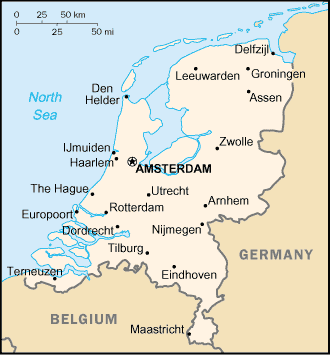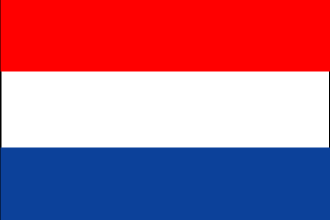
|
Netherlands
Background:
The Kingdom of the Netherlands was formed in 1815. In 1830 Belgium seceded and
formed a separate kingdom. The Netherlands remained neutral in World War I but
suffered a brutal invasion and occupation by Germany in World War II. A modern,
industrialized nation, the Netherlands is also a large exporter of agricultural
products. The country was a founding member of NATO and the EC, and
participated in the introduction of the Economic and Monetary Union (EMU) in
1999.
Location:
Western Europe, bordering the North Sea, between Belgium and Germany.
Area: Total: 41,526 sq km, water: 7,643 sq km, land: 33,883 sq km.
Area - comparative: Slightly less than twice the size of New Jersey.
Land boundaries: Total: 1,027 km, border countries: Belgium 450 km, Germany
577 km.
Coastline: 451 km
Climate and Terrain:
Climate: Temperate; marine; cool summers and mild winters.
Terrain: Mostly coastal lowland and reclaimed land (polders); some hills in
southeast.
Elevation extremes: Lowest point: Zuidplaspolder -7 m, highest point:
Vaalserberg 322 m.
Natural resources: Natural gas, petroleum, arable land.
People:
Population: 16,067,754.
Ethnic groups: Dutch 83%, other 17% (of which 9% are non-western origin mainly
Turks, Moroccans, Antilleans, Surinamese and Indonesians.
Religions: Roman Catholic 31%, Protestant 21%, Muslim 4.4%, other 3.6%,
unaffiliated 40%.
Languages: Dutch.
Government:
Government type: Constitutional monarchy.
Capital: Amsterdam; The Hague is the seat of government.
Independence: 1579 (from Spain).
Dependent areas: Aruba, Netherlands Antilles.
Economy overview:
The Netherlands is a prosperous and open economy depending heavily on foreign
trade. The economy is noted for stable industrial relations, moderate
inflation, a sizable current account surplus, and an important role as a
European transportation hub. Industrial activity is predominantly in food
processing, chemicals, petroleum refining, and electrical machinery. A highly
mechanized agricultural sector employs no more than 4% of the labor force but
provides large surpluses for the food-processing industry and for exports. The
Netherlands, along with 11 of its EU partners, began circulating the euro
currency on 1 January 2002.
Statistics:
Telephones - main lines in use: 9,132,400.
Telephones - mobile cellular: 4,081,891.
Radio broadcast stations: AM 4, FM 58, shortwave 3.
Radios: 15.3 million.
Television broadcast stations: 21 (plus 26 repeaters).
Televisions: 8.1 million.
Internet users: 8.7 million.
Railways: Total: 2,808 km.
Highways: Total: 116,500 km, paved: 104,850 km, unpaved: 11,650 km.
Airports: 28, with paved runways: 20, with unpaved runways: 8.
Heliports: 1.
Return to Visiting Locations
|

